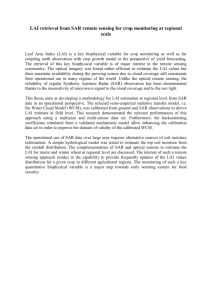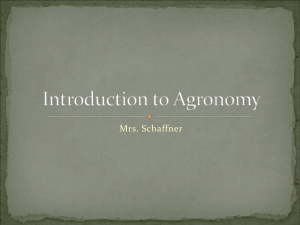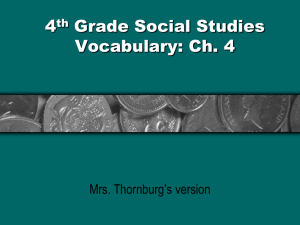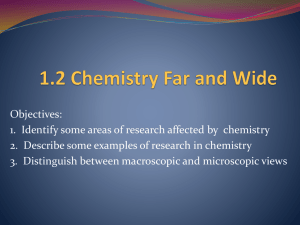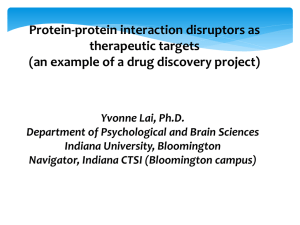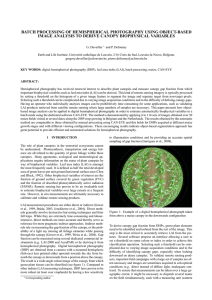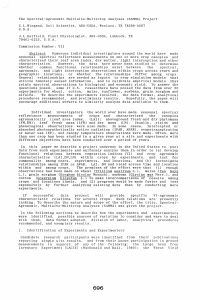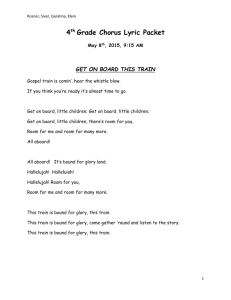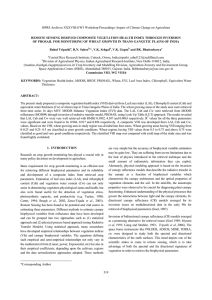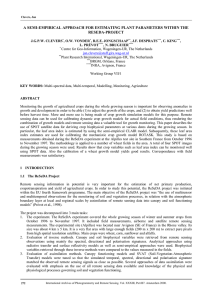Earth Observation for Agriculture * State of the Art
advertisement
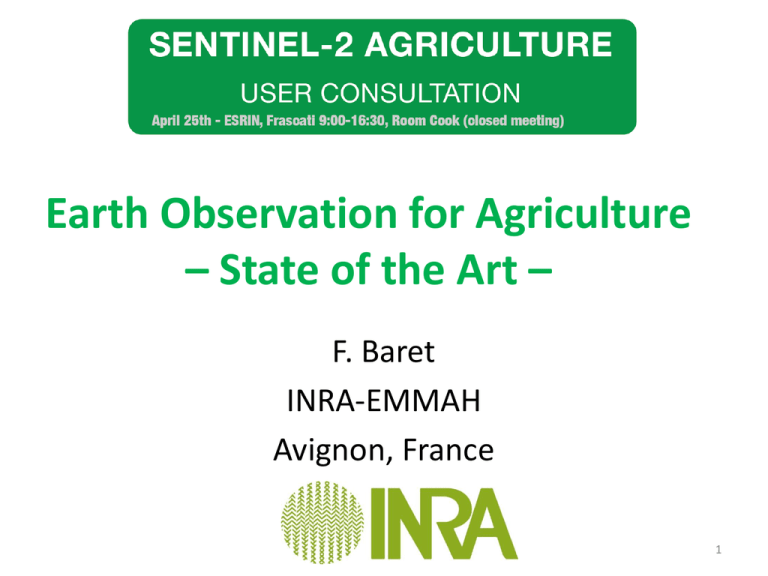
Earth Observation for Agriculture – State of the Art – F. Baret INRA-EMMAH Avignon, France 1 Outlook • The several needs for agriculture • Observational Requirements – Variables targeted / accessible – Spatial – Temporal • Retrieval of key variables from S2 observations – Generic algorithm – Specific algorithm – Assimilation • Conclusion/recommandations 2 The several needs for agriculture Precision agriculture Local Tools Seeds Dealers Consultants Cooperatives Statistics Governments Fertilizer Pesticide Farmers Traders Food Industry Regional/International Control Insurance Food Industry Governments 3 From observations to applications Assimilation of radiances Structure Atmosphere Biochemical content Canopy Functioning Models Soil Biophysical variables estimates (Products) • • Assimilation of Products Need for biophysical products (LAI, fAPAR, fCover, Albedo) and their dynamics – – – – – Used as indicators for decision making Input to crop process models Smooth expected temporal course (allows smoothing / real time estimates) Allows validation Provide uncertainties Need for crop classification 4 Observational requirements: Variables targetted (and accessible!) Biophysical variables of interest: • • • • • • LAI (actually GAI) Green fraction (FAPAR, FCOVER) Chlorophyll content Water content Soil related characteristics Crop residue estimates 5 Spectral requirements • Correction for the atmosphere • Sampling the absorption of main leaf constituants 6 Observational requirements: Spatial resolution • Precision agriculture: intra-field variability • Other applications: – Fields – Species (regional assessment of production) Number of patches/pixel Purity of pixel Variability within pixel Large differences between 10-20-60 m with 100-250-1000m 7 Observational requirements: Revisit frequency • Providing information on crop state at specific stages (± 1 week) • Monitoring crops for resources management Green Fraction Green Fraction Getting information every 100°C.day: - One month in winter - 5 days in summer Accounting for clouds (≈50% occurence) 8 Retrieval of key variables from S2: Generic algorithms • Applicable everywhere with variable accuracy but good consistency • Allows continuity with hectometric/kilometric observations • Based on simple assumptions on canopy structure 9 Retrieval of key variables from S2: Generic algorithms applied to several sensors Rapideye SPOT4 IRS SPOT4 Landsat Landsat SPOT4 SPOT4 DMC Time Grassland_1 Grassland_2 Shrubland Forest (oak) Capacity to build a consistent time series from multiple sensors Virtual constellation Possible spectral sensitivity residual effects 10 Retrieval of key variables from S2: Specific algorithms • Need knowledge of land-use (species / cultivars) – On the fly land-use (continuously updated) • Allows using prior distribution of canopy characteristics – Canopy Structure – Leaf properties (structure, chlorophyll, SLA, water, surface effects • Need calibration over – detailed radiative transfer model – Comprehensive experiments 11 Calibration over radiative transfer models Specific (3D) Estimated LAI Maize Estimated LAI Generic (Turbid) Measured LAI Estimated LAI Estimated LAI Vineyard Measured LAI Measured LAI Measured LAI Better use more realistic 3D model than turbid medium (generic) model From Lopez-Lozano, 2007 12 Use of (HT) phenotyping / agronomical Experiments Characterize specific structural traits Green Fraction Calibration over experiments 13 Combination with crop models Ancillary Information/data Radiance observations Radiative Transfer Model Diagnostic variables Process model (dynamic) Variables of interest Model Parameters Assimilation allows to: • input additional information in the system: – Knowledge on some processes – Exploitation of ancillary data (climate, soil, …) • exploit the temporal dimension: process model as a link between dates • access specific processes / outputs (biomass, yield, nitrogen balance) • Run process models in prognostic mode : simulations for other conditions 14 Combination with crop models Example of assimilation Question: How to optimize the nitrogen amount for a field crop ? Inputs: • Climate (past) • Soil (Prior knowledge of characteristics, but no spatial variability) • Technical practices (sowing date, …) • Crop model (STICS) and some crop parameters • 3 flights with CASI instrument Outputs: • Map of nitrogen content (QN) 200 000 cas Prior distribution of inputs Climate past' Soil Prior QN (kg/ha) Assimilation of (RS) observations Flight 3 Flight 2 Flight 1 Crop model Cultural Pract. Actual QN (kg/ha) Remote sensing Estimates LAI, Cab 1 000 cases Cost function Posterior distribution of inputs Posterior QN (kg/ha) Prior distribution of outputs LAI, Cab Flight 3 Flight 2 Flight 1 Actual QN (kg/ha) 16 Conclusion & Recommandations • S2 very well adapted to requirements for agriculture • Following issues to be solved: • Organize the validation / calibration to capitalize on the work done • Build an archive (anomalies) • Fusion with other missions for improved revisit frequency at the level of biophysical variables (or higher) products – decametric missions (Rapid-eye, DMC, Venµs, , SPOT6/7, LDCM…) – hectometric resolution observations (PROBA-V, S3 …) • Development of algorithms for: – – – – Top of canopy fused products at 10 m resolution and original resolutions on the fly classification (continuously updated) specific products per crop/cultivar Patch (object) oriented algorithm to take into account • the continuity within patches • The variability within patches (texture) • Development of combination of S2 data with crop models (Assimilation) – Improved description of canopy structure by models in relation to function – Simplification of crop models (meta-model) 17
